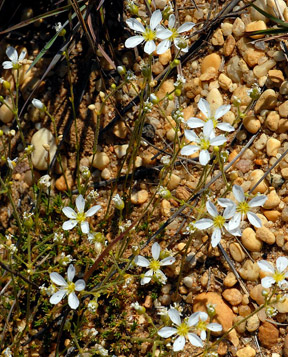Lakehurst Road, Browns Mills, NJ 08015
Phone: (609) 726-1191
www.whitesbog.org
NJ Department of Environmental Protection
From the office at Brendan T. Byrne State Forest, take the North exit from the parking lot onto Four Mile Road. After 0.6 miles, turn Right onto Route 70. After 4.5 miles, turn Left on an unmarked sand road near two white mailboxes. This is Whitesbog Road. Proceed for 1.3 miles, crossing Lakehurst Road, to Historic Whitesbog Village. DIRECTIONS FROM NEAREST HIGHWAY: From the intersection of Route 70 and Route 72 at Four Mile traffic circle, continue East on Route 70. After 6.8 miles, turn sharp Left on Route 530, Lakehurst Road. After 1.2 miles, turn Right onto Whites Bog Road, the entrance to Whitesbog Village. Map
Annual Blueberry Festival held in July each year.
Water lilies, both white and pink, cover several of the reservoirs in the area in the summer months.
 |
| Pine Barrens Sandwort | Rick Radis |
| |
| | Historic Whitesbog is one of New Jersey’s best examples of a site worthy of exploration from many points of interest, including nature, history and agriculture. Now part of Brendan Byrne State Forest, the site holds a preserved turn-of-the century blueberry/cranberry village, surrounding forest, abandoned cranberry bogs, and active cranberry bogs that have been leased back by the State to the commercial cranberry growers that bear the name of the village founders. After exploring the town, drive the five-mile scenic auto tour, which engulfs visitors in a true Pine Barrens experience. The auto tour begins in the village and meanders around dikes and through wooded areas, all marked by numbered posts. The auto trail is easily navigable, and is best enjoyed when accompanied by a trail guide, which can be purchased in the General Store. Maps of the area are available in the kiosk.
Tundra Swans are reliable winter visitors, and are usually present as long as there is some open water. Other waterfowl and Kingfisher are often present, and there is a good chance of seeing a Bald Eagle. Listen for Great Horned Owl and Screech Owl at dusk.
Look for Yellow-billed Cuckoo, Red-winged Blackbird, Northern and Orchard Orioles among the numerous and varied songbirds. Listen for the song of the Pine Warbler, perhaps the most typical bird of the area. This may be the best time to find the State-listed Northern Bobwhite or Ruffed Grouse, which have become extremely rare in the Pine Barrens. Fowler’s toads, leopard frog, carpenter frog, and even the rare Pine Barrens treefrog can often be heard calling in daylight, on warm, rainy days in May.
Spring comes late to the barrens, and some of the most characteristic plants, such as pine barrens sandwort, Virginia meadow-beauty, and orange milkwort do not start to flower until June. Look for them on the roadsides. Blueberries ripen in July and make a tasty impromptu snack. Nesting birds include Green-winged Teal, Black Duck, Wood Duck, Mallard, Pied-billed Grebe, American Bittern, and Virginia Rail.
In late summer and early Fall, water levels in the reservoirs are often low, exposing mud flats which attract migrating shorebirds such as Least, Semipalmated, Spotted and Pectoral Sandpipers, Greater and Lesser Yellowlegs, Common Snipe, and Killdeer. Watch for Wild Turkey and the occasional Ring-Necked Pheasant crossing the sand roads. Cranberries are harvested in October – a sight worth seeing.
|